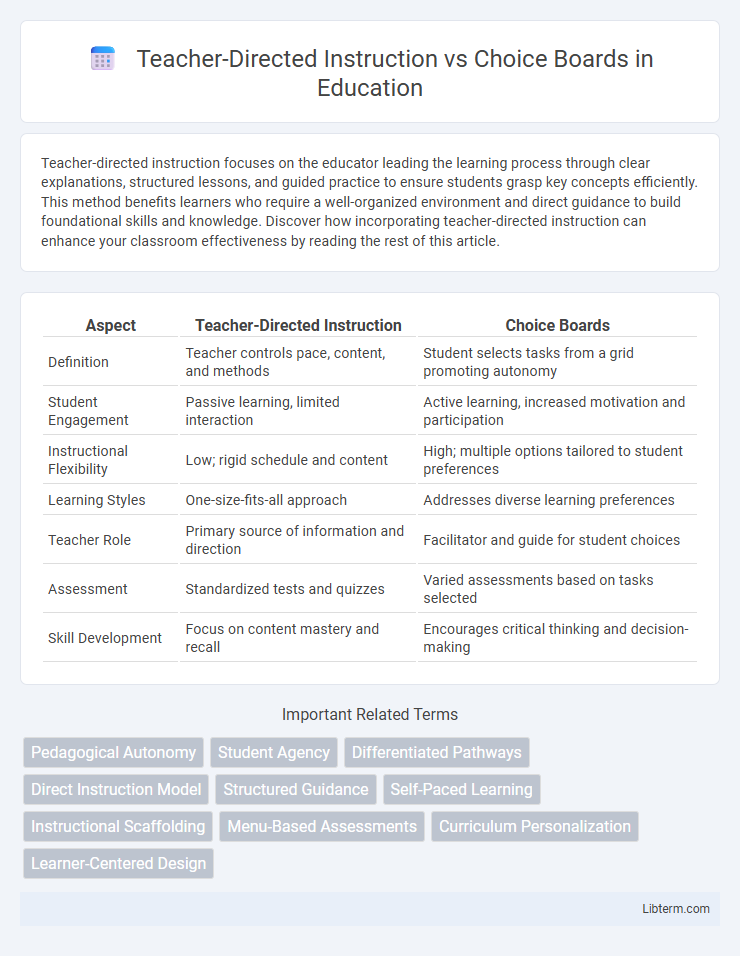Teacher-directed instruction focuses on the educator leading the learning process through clear explanations, structured lessons, and guided practice to ensure students grasp key concepts efficiently. This method benefits learners who require a well-organized environment and direct guidance to build foundational skills and knowledge. Discover how incorporating teacher-directed instruction can enhance your classroom effectiveness by reading the rest of this article.
Table of Comparison
| Aspect | Teacher-Directed Instruction | Choice Boards |
|---|---|---|
| Definition | Teacher controls pace, content, and methods | Student selects tasks from a grid promoting autonomy |
| Student Engagement | Passive learning, limited interaction | Active learning, increased motivation and participation |
| Instructional Flexibility | Low; rigid schedule and content | High; multiple options tailored to student preferences |
| Learning Styles | One-size-fits-all approach | Addresses diverse learning preferences |
| Teacher Role | Primary source of information and direction | Facilitator and guide for student choices |
| Assessment | Standardized tests and quizzes | Varied assessments based on tasks selected |
| Skill Development | Focus on content mastery and recall | Encourages critical thinking and decision-making |
Understanding Teacher-Directed Instruction
Teacher-directed instruction centers on the educator's explicit guidance to deliver structured lessons, emphasizing clear objectives and direct assessment methods. This approach promotes consistent content delivery and maintains classroom control, facilitating efficient knowledge transfer aligned with curriculum standards. Research shows it enhances foundational skill acquisition, especially in early education settings and subjects requiring step-by-step mastery.
What Are Choice Boards in Education?
Choice boards in education are structured frameworks that allow students to select from a variety of learning activities tailored to different learning styles and interests, promoting autonomy and engagement. Unlike teacher-directed instruction, which follows a fixed curriculum and pace set by the instructor, choice boards provide flexibility and encourage student-centered learning by offering multiple pathways to demonstrate understanding. This approach supports differentiated instruction and can improve motivation, critical thinking, and personalized learning outcomes.
Key Differences Between Teacher-Directed Instruction and Choice Boards
Teacher-Directed Instruction centers on a structured, teacher-led approach where lessons are delivered uniformly to all students, emphasizing direct guidance and standardized assessments. Choice Boards provide students with a variety of learning activities to select from, promoting autonomy, differentiated learning, and engagement through personalized pathways. The key difference lies in the control over learning processes: Teacher-Directed Instruction is instructor-controlled, while Choice Boards empower student choice and adaptive pacing.
Benefits of Teacher-Directed Instruction
Teacher-directed instruction provides a structured learning environment that ensures consistent curriculum coverage and clear expectations, which enhances student comprehension and retention. This method allows teachers to deliver targeted content efficiently, monitor student progress in real-time, and address misconceptions immediately. The direct approach supports classroom management and systematic skill development, making it ideal for foundational knowledge acquisition and standardized assessment preparation.
Advantages of Using Choice Boards in the Classroom
Choice boards empower students by offering personalized learning paths that accommodate diverse learning styles and paces, enhancing engagement and motivation. They promote critical thinking and decision-making skills by allowing students to select activities that align with their interests and strengths, leading to deeper understanding and retention. Implementing choice boards reduces teacher workload in lesson differentiation while fostering student autonomy and accountability in the learning process.
Challenges of Teacher-Directed Instruction
Teacher-directed instruction often faces challenges such as limited student engagement and reduced opportunities for personalized learning. This method can constrain creativity and critical thinking by emphasizing teacher control and standardized pacing. These limitations may hinder differentiation and fail to address the diverse learning needs of students effectively.
Potential Drawbacks of Choice Boards
Choice boards, while promoting student autonomy and engagement, may lead to inconsistent skill development due to varied task selections that do not always align with curriculum standards. Students might experience decision paralysis or select tasks based on ease rather than learning value, reducing overall instructional effectiveness. Furthermore, teachers face challenges in monitoring progress and providing targeted feedback, potentially hindering personalized learning outcomes.
Impact on Student Engagement and Motivation
Teacher-directed instruction offers structured guidance that can enhance student focus and clarity, fostering motivation through clear expectations and immediate feedback. Choice boards provide personalized learning paths, boosting engagement by allowing students to select tasks that align with their interests and learning styles. Combining both methods can create a balanced environment that supports diverse motivation triggers and sustained student involvement.
Choosing the Right Approach for Diverse Learners
Teacher-directed instruction provides structured guidance and clear learning objectives ideal for students needing explicit support, while choice boards offer flexible, student-centered options promoting autonomy and engagement. Selecting the right approach depends on learners' individual needs, readiness levels, and preferences to balance direction with independence. Effective differentiation often blends direct teaching with choice boards to accommodate diverse cognitive and motivational profiles.
Integrating Teacher-Directed Methods and Choice Boards for Optimal Outcomes
Combining teacher-directed instruction with choice boards enhances student engagement and learning outcomes by balancing structured guidance and personalized learning paths. Teacher-directed methods provide clear objectives and foundational knowledge, while choice boards empower students to select activities that align with their interests and learning styles. This integration fosters deeper understanding, motivation, and autonomy, resulting in more effective and differentiated instruction.
Teacher-Directed Instruction Infographic

 libterm.com
libterm.com